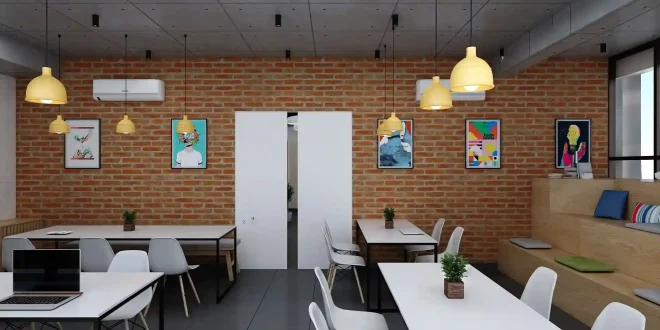Introduction
When it comes to establishing a strong brand presence and enhancing the overall experience for customers, the design of your commercial space plays a pivotal role. Whether you own a retail store, an office, a restaurant, or a hotel, your commercial interior design can set the tone for your brand, attract potential clients, and create a memorable environment for employees and visitors alike. A well-designed commercial space goes beyond aesthetics; it integrates function, comfort, and style to create a space that enhances productivity, promotes customer satisfaction, and embodies your business’s core values.
In this article, we will explore how to create a functional and stylish commercial interior design that aligns with your brand while ensuring an efficient and comfortable space for both employees and clients. From the initial design concept to the final execution, we’ll walk you through key considerations to make sure your commercial interior design stands out and serves its intended purpose.
Why Commercial Interior Design Matters
Commercial interior design is much more than simply beautifying a space—it directly influences the way customers and employees interact with the space. A well-thought-out design can improve customer satisfaction, increase employee morale, and contribute to the success of your business. Whether you’re aiming to impress clients, boost brand recognition, or create a more efficient work environment, the design elements you choose will leave a lasting impression.
Good commercial interior design offers the following benefits:
- Brand Identity: Your space should reflect your brand’s ethos, values, and message. The design should speak to your target audience and convey your business’s personality.
- Functionality: An efficient layout helps improve workflow, optimize space usage, and increase productivity.
- Customer Experience: An inviting and well-designed space can enhance the overall experience for your customers, encouraging them to return.
- Employee Satisfaction: A well-designed workspace can improve employee morale, reduce stress, and create a positive, collaborative atmosphere.
With the right balance of aesthetics, functionality, and practicality, commercial interior design can become a key differentiator for your business.
Key Considerations for a Successful Commercial Interior Design
When designing a commercial space, it’s important to consider several key factors that will contribute to the overall functionality, aesthetics, and success of the design. Let’s explore these in detail.
1. Understand Your Brand and Target Audience
Your commercial space should reflect your brand’s identity and resonate with your target audience. Whether your business is casual, luxurious, cutting-edge, or traditional, your interior design should mirror those attributes. Consider your brand’s values, mission, and style when choosing colors, furniture, materials, and layout.
- Brand Consistency: Ensure that the interior design complements your brand’s colors, logo, and tone. If you run a tech company, your space might benefit from sleek, modern furniture and tech-savvy features. A law firm, on the other hand, might call for a more traditional, sophisticated design with rich wood finishes and leather furniture.
- Target Audience: Consider who your customers are. A kid-friendly toy store would benefit from bright colors, playful patterns, and interactive displays, while a high-end fashion boutique would require elegant, minimalist décor and soft lighting.
Design Tip: Use your brand’s logo and color palette in subtle ways throughout your space, whether through wall accents, signage, or furniture.
2. Maximize Space and Functionality
The primary purpose of commercial interior design is to create a functional environment that works for your business. An efficient layout ensures that both employees and customers can navigate the space with ease and comfort. An optimized layout can improve workflow, enhance the customer experience, and help make the most of your available square footage.
- Open vs. Closed Layout: Depending on your business type, you may want an open-plan layout that encourages collaboration (e.g., in offices or creative workspaces) or closed-off areas for privacy and focus (e.g., in consulting offices or medical practices).
- Flow and Circulation: Ensure that your space is easy to navigate. The layout should guide customers seamlessly through the space, whether it’s a retail store, restaurant, or office.
- Multifunctional Spaces: Especially in businesses where space is limited (e.g., small offices, restaurants, or retail stores), consider multifunctional furniture that can serve multiple purposes.
Design Tip: Use partitions, furniture arrangement, and lighting to create different zones for various activities—whether it’s an open working area, private meeting spaces, or retail displays.
3. Lighting as a Design Element
Lighting plays a critical role in commercial interior design. Not only does it serve a functional purpose, but it also enhances the mood and atmosphere of your space. Poor lighting can make even the most stylish interiors look dull, while the right lighting can add warmth, drama, and vibrancy.
- Ambient Lighting: This is the general lighting for the entire space. Use recessed lighting, pendant lights, or ceiling-mounted fixtures for an evenly lit environment.
- Task Lighting: In areas where specific tasks are performed, such as workstations or reading areas, incorporate task lighting like desk lamps or under-cabinet lights.
- Accent Lighting: Use accent lighting to highlight key design features, artwork, or retail displays. Spotlights, track lighting, and LED strips are ideal for this purpose.
- Natural Light: Maximize the use of natural light wherever possible. Large windows, skylights, or glass doors can provide an influx of natural light that improves both the aesthetics and the health of your space.
Design Tip: Install dimmable lights to control the ambiance based on the time of day and the specific function of the space.
4. Choose the Right Furniture and Fixtures
Furniture and fixtures contribute significantly to the overall look and feel of your commercial space. However, it’s important to remember that comfort, durability, and functionality should be prioritized alongside style.
- Ergonomic Furniture: For businesses where employees spend long hours sitting, such as offices or call centers, invest in ergonomic chairs, desks, and seating solutions that promote health and productivity.
- Durable Materials: Since commercial spaces experience heavy foot traffic, choose furniture and fixtures made from durable materials that are easy to maintain. Commercial-grade fabrics, leather, wood, and metals are ideal choices.
- Statement Pieces: Depending on the type of business, you might want to incorporate one or two statement furniture pieces that can act as a conversation starter or draw attention to a particular area (e.g., a large, bold conference table in an office or an eye-catching display in a retail store).
Design Tip: Keep furniture and fixtures aligned with your brand identity, and ensure they are proportionate to the scale of the space.
5. Incorporate Color, Textures, and Patterns
Color has a profound impact on the mood and perception of a space. When choosing a color scheme for your commercial interior design, think about how colors influence behavior and emotions.
- Color Psychology: Bright, vibrant colors like yellow and orange evoke energy and creativity, while cooler tones like blue and green are calming and conducive to focus. Think about what mood you want to set and how it aligns with your business goals.
- Texture and Materials: Mix and match textures and materials to add depth and interest to your space. Incorporate natural elements like wood, stone, or glass to create warmth and authenticity. Fabrics such as velvet, linen, or leather can elevate the design and introduce tactile variety.
- Patterns: While bold patterns can create a unique statement, they must be used carefully. Avoid overwhelming the space with too many competing patterns. Instead, balance them with solid colors to maintain harmony.
Design Tip: Stick to a cohesive color palette throughout the space to ensure visual consistency and a professional look.
Conclusion
Creating a functional and stylish commercial interior design for your business is an investment that pays off in terms of customer satisfaction, employee productivity, and overall brand identity. By understanding your brand, maximizing space and functionality, integrating technology, and thoughtfully incorporating lighting, furniture, and decor, you can design a space that reflects your business’s values while optimizing the experience for everyone who steps through your doors.
Whether you’re designing a chic retail store, a modern office, or an inviting restaurant, the key is to balance aesthetics with practicality. A well-designed commercial space not only looks great but also serves its intended purpose efficiently, creating a lasting impression on both clients and employees.
 Crypto trade Online Unlock the Future of Finance Today.
Crypto trade Online Unlock the Future of Finance Today.




